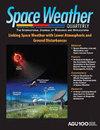基于集合迁移学习的热层质量密度短期预测
IF 3.8
2区 地球科学
Q2 ASTRONOMY & ASTROPHYSICS
Space Weather-The International Journal of Research and Applications
Pub Date : 2023-10-01
DOI:10.1029/2023sw003576
引用次数: 0
摘要
对卫星轨道上的热层质量密度进行可靠的短期预测一直是低地球轨道卫星运行的必要条件,但也具有挑战性。本文研究了三种机器学习预测算法,包括双向长短期记忆、变压器和上述模型的光梯度增强机(LightGBM)集成模型。我们使用来自CHAMP、GOCE和SWARM - C的卫星数据来评估不同密度变化的稳健性和准确性。比较表明,所有模型都实现了令人信服的预测,并且比NRLMSISE‐00要好得多。LightGBM集成模型(LE‐model)在准确性和稳定性方面始终优于其他模型。此外,当新发射卫星获得的密度数据有限时,训练后的LE‐模型可以通过迁移学习对新卫星轨道进行有效的预测。该研究为利用集合迁移学习对热层质量密度的短期预测提供了有希望的见解,并可能有利于未来对空间是否存在的研究。本文章由计算机程序翻译,如有差异,请以英文原文为准。
The Short‐Time Prediction of Thermospheric Mass Density Based on Ensemble‐Transfer Learning
Abstract Reliable short‐time prediction of thermospheric mass density along the satellite orbit is always essential but challenging for the operation of Low‐Earth orbit satellites. In this paper, three machine‐learning prediction algorithms are investigated, including the Bidirectional Long Short‐Term Memory, the Transformer, and the Light Gradient Boosting Machine (LightGBM) ensemble model of the above models. We use satellite data from CHAMP, GOCE, and SWARM‐C to evaluate the robustness and accuracy of different density variations. The comparison demonstrates that all models achieve compelling predictions and are much better than NRLMSISE‐00. The LightGBM ensemble model (LE‐model) consistently outperforms others in accuracy and stability. Furthermore, when the obtained density data from the newly launched satellites are limited, the trained LE‐model can provide a valid prediction for the new satellite orbit by transfer learning. This study offers a promising insight into the short‐time prediction of thermospheric mass density using ensemble‐transfer learning and may be advantageous to future research on space whether.
求助全文
通过发布文献求助,成功后即可免费获取论文全文。
去求助
来源期刊
CiteScore
5.90
自引率
29.70%
发文量
166
审稿时长
>12 weeks
期刊介绍:
Space Weather: The International Journal of Research and Applications (SWE) is devoted to understanding and forecasting space weather. The scope of understanding and forecasting includes: origins, propagation and interactions of solar-produced processes within geospace; interactions in Earth’s space-atmosphere interface region produced by disturbances from above and below; influences of cosmic rays on humans, hardware, and signals; and comparisons of these types of interactions and influences with the atmospheres of neighboring planets and Earth’s moon. Manuscripts should emphasize impacts on technical systems including telecommunications, transportation, electric power, satellite navigation, avionics/spacecraft design and operations, human spaceflight, and other systems. Manuscripts that describe models or space environment climatology should clearly state how the results can be applied.

 求助内容:
求助内容: 应助结果提醒方式:
应助结果提醒方式:


